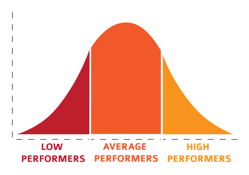– By Phoebe Yee, Director of Brain Matter
Bell Curve. You probably have heard of this word and repeatedly being told that you need to be at the right side of this curve. So, what is this all about?
Bell Curve is a statistic curve that represents data and follows the Normal Distribution. To put it in plain English, this curve tells us that majority of people will score averagely and a minority of people will score either badly or very well. This bell curve can also be translated to a cumulative frequency curve, which we are more familiar with as this is part of our ‘O’ level Math Syllabus.
But, the question is this: Why are schools so certain that the performance of students taking any exams will follow this bell-curve trend? Is there something really so special about this curve? Or, is there something special about the papers set in examinations?
We must understand that the purpose of any testing is to evaluate the ability of the students. A good and well-crafted exam paper is one that is able to sift out the low-performing students from the average-performing students and them from the high-performing students. And the secret to that lies in the type of questions that come out in the exams.
When I was working as an MOE teacher, I recalled that I had to set exam papers for the cohort of students I was teaching. To be frank, I don’t enjoy it. Totally don’t. It can get quite boring. And I’m making a bold guess that most teachers don’t like. But one of the things I do to help myself is to decide the following on the onset:
- Number of questions and the number of parts (Usually these are fixed by our HODs)
- Topics to be tested for which question (I need to make sure all the topics taught are covered)
- Level of difficulty of each question
A typical planning sheet will look like this:
| Question | Topic | Level of difficulty | No of Marks |
| 1 | Discriminants | 2 | 5 |
| 2 | Sum and Product of Roots | 1 | 3 |
| 3 | Quadratic Inequalities + Logarithm | 3 | 7 |
| … | … | … | |
| Total | Topic 1- 2 Qns Topic 2- 3 Qns Topic 3- 1 Qn … |
– | 80 |
I will always need to look through the planning sheet and adjust accordingly to make sure the paper consists of easy, intermediate and challenging questions. And once I get this done, I’ll source out or craft out questions that fulfills the requirement of each question that I planned for. This will save a lot of time. If you are a teacher reading this, you’re free to use this idea for yourself.
I will always need to look through the planning sheet and adjust accordingly to make sure the paper consists of easy, intermediate and challenging questions. And once I get this done, I’ll source out or craft out questions that fulfills the requirement of each question that I planned for. This will save a lot of time. If you are a teacher reading this, you’re free to use this idea for yourself.
Often I hear students saying this about Math Exams Papers with 2 parts. Those topics that did not come out in Paper 1 will definitely come out in Paper 2. There’s some truth in it because your teachers do need to test all the topics taught! However, do take note that it doesn’t necessarily means that topics that came out in Paper 1 will NOT come out in Paper 2.
Some times, teachers may not be as hardworking as we think they are. And this means they may follow the exact format of the past year examination papers and reuse some questions with just a change in the numbers in the question. Now, you know why it’s so important to attempt past year examinations questions and get them right… Yes, in case the teacher who sets the paper is one of those types of teacher that I mentioned earlier.
Hope this has helped you to understand more from a teacher’s perspective when she sets the exams questions.
In my next article, I’ll touch on how to spot the easy, standard and challenging questions from your daily practice and homework given by your teachers. Knowing them will help to put your learning into a framework and allow you to see everything from a bigger perspective. Stay tuned.

